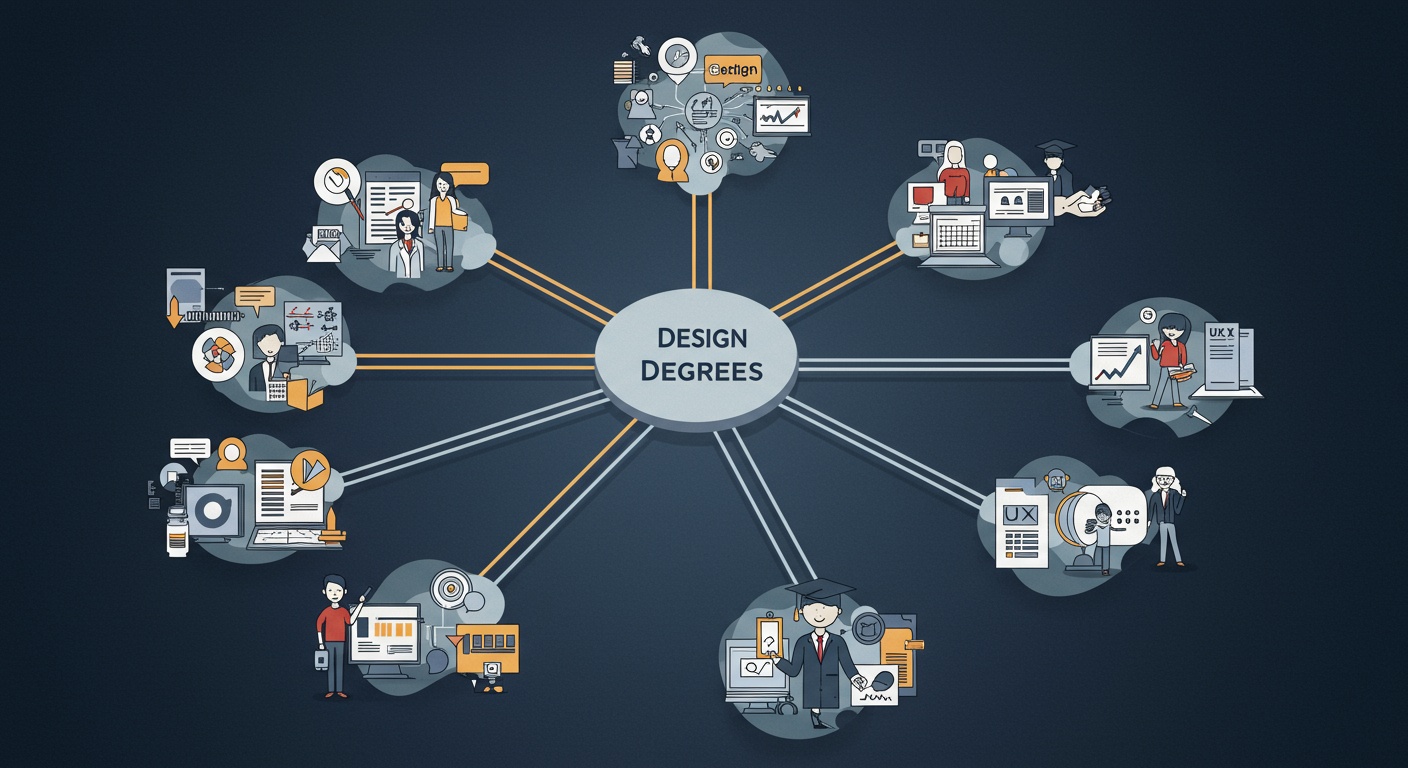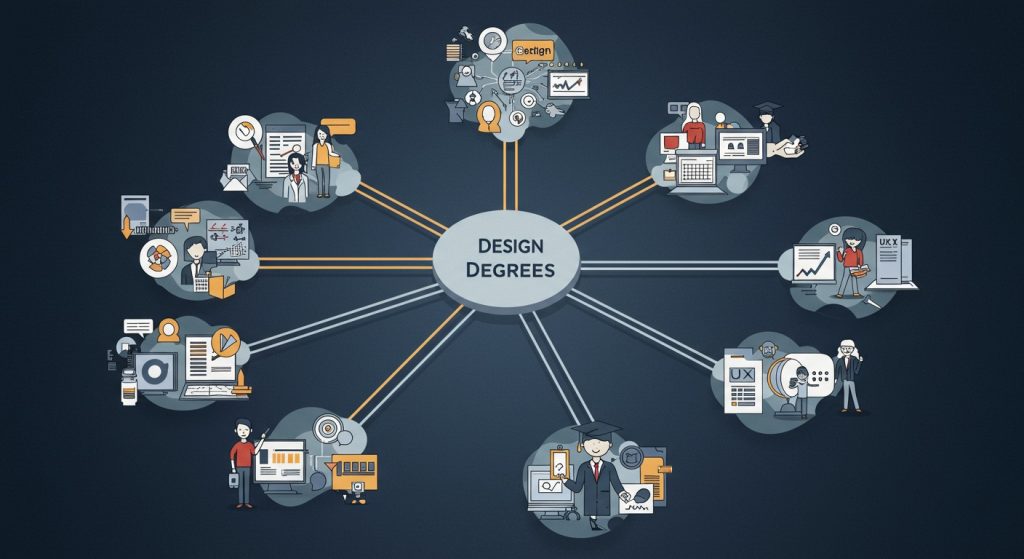The design landscape is evolving faster than ever, driven by AI-powered tools and a surging demand for user-centric experiences. Forget the outdated notion of a generic “design degree.” Today, specializations are key. Are you drawn to crafting immersive virtual worlds through a game design degree, or perhaps shaping intuitive interfaces as a UX/UI specialist? Maybe you envision yourself branding sustainable products with a focus on packaging design, addressing the growing consumer consciousness. Understanding these diverse paths – from graphic design’s continued relevance in digital marketing to the architectural designer’s role in smart cities – is crucial. Your future career hinges on choosing the right specialization and mastering the skills demanded by these rapidly changing fields. Let’s decode your options.

Navigating the World of Design Degrees: A Guide to Specializations
Choosing a design degree can feel overwhelming. The creative landscape is vast, with numerous specializations catering to different interests and career paths. This guide breaks down common design degree specializations, helping you comprehend the nuances of each and identify the best fit for your future aspirations.
Graphic Design: Visual Communication at its Finest
Graphic design is perhaps the most widely recognized design discipline. It focuses on visual communication, using typography, imagery. Layout to convey messages and create visual identities.
- Key Skills: Proficiency in design software (Adobe Photoshop, Illustrator, InDesign), strong understanding of typography, color theory, layout principles. Branding.
- Typical Projects: Logos, brochures, websites, marketing materials, packaging. User interface (UI) elements.
- Career Paths: Graphic Designer, Art Director, Brand Manager, Web Designer, UI Designer, Marketing Specialist.
Graphic design is the backbone of visual communication for businesses and organizations. It is essential for creating impactful branding, effective marketing campaigns. User-friendly websites.
Web Design: Crafting the Digital Experience
Web design blends artistic creativity with technical know-how. It focuses on the planning, creation. Maintenance of websites, ensuring they are visually appealing, user-friendly. Functional.
- Key Skills: Understanding of HTML, CSS, JavaScript, responsive design principles, user experience (UX) design. Content management systems (CMS) like WordPress.
- Typical Projects: Website layouts, user interface design, front-end development, e-commerce platforms. Mobile-responsive designs.
- Career Paths: Web Designer, Front-End Developer, UX Designer, UI Designer, Web Developer, E-commerce Specialist.
Web design is crucial in today’s digital age. A well-designed website can significantly impact a business’s online presence, customer engagement. Overall success.
UX/UI Design: Designing for User Satisfaction
UX (User Experience) and UI (User Interface) design are often grouped together. They represent distinct aspects of product design. UX focuses on the overall experience a user has with a product, ensuring it is intuitive, efficient. Enjoyable. UI focuses on the visual elements of the interface, ensuring it is aesthetically pleasing and easy to interact with.
- Key Skills: User research, wireframing, prototyping, usability testing, data architecture, visual design principles. Knowledge of design software like Sketch, Figma. Adobe XD.
- Typical Projects: Mobile app design, website redesign, software interface design, user flow diagrams. Usability testing reports.
- Career Paths: UX Designer, UI Designer, UX Researcher, Interaction Designer, Product Designer.
Companies are increasingly recognizing the importance of UX/UI design. By prioritizing user satisfaction, businesses can create products that are more engaging, effective. Ultimately, more successful.
Industrial Design: Shaping the Physical World
Industrial design focuses on the design of physical products, considering both aesthetics and functionality. Industrial designers work to improve the usability, appearance. Manufacturing process of everything from household appliances to automobiles.
- Key Skills: Sketching, 3D modeling (using software like SolidWorks, Rhino, or Autodesk Inventor), prototyping, understanding of materials and manufacturing processes. Knowledge of ergonomics.
- Typical Projects: Product design, furniture design, transportation design, medical device design. Consumer electronics design.
- Career Paths: Industrial Designer, Product Designer, Design Engineer, Furniture Designer, Transportation Designer.
Industrial design plays a vital role in shaping the products we use every day. By combining creativity with technical expertise, industrial designers create products that are both beautiful and functional.
Interior Design: Creating Functional and Beautiful Spaces
Interior design focuses on the design and planning of interior spaces, considering factors such as functionality, aesthetics, safety. Sustainability. Interior designers work to create spaces that are both visually appealing and meet the needs of the people who use them.
- Key Skills: Space planning, knowledge of building codes, understanding of materials and finishes, proficiency in CAD software (AutoCAD, Revit). Strong communication and presentation skills.
- Typical Projects: Residential design, commercial design, hospitality design, healthcare design. Sustainable design.
- Career Paths: Interior Designer, Interior Architect, Space Planner, Kitchen and Bath Designer, Sustainable Design Consultant.
Interior design is essential for creating spaces that are not only beautiful but also functional and safe. Interior designers play a crucial role in improving the quality of life for people in both residential and commercial settings.
Fashion Design: Expressing Creativity Through Clothing
Fashion design involves creating original designs for clothing and accessories, considering factors such as trends, materials. Target audience. Fashion designers are responsible for the entire design process, from sketching initial ideas to overseeing the production of finished garments.
- Key Skills: Sketching, draping, pattern making, sewing, knowledge of textiles and fashion history. Understanding of market trends.
- Typical Projects: Clothing design, accessory design, textile design. Fashion show production.
- Career Paths: Fashion Designer, Textile Designer, Pattern Maker, Stylist, Fashion Buyer.
Fashion design is a dynamic and competitive field that offers opportunities for creative expression and innovation. Fashion designers play a significant role in shaping the way people dress and express themselves.
Animation and Game Design: Bringing Worlds to Life
Animation and game design are rapidly growing fields that combine artistic creativity with technical skills. Animators create moving images for films, television, video games. Other media. Game designers are responsible for the overall design and development of video games, including gameplay mechanics, story. Character design.
- Key Skills: Proficiency in animation software (Maya, 3D Studio Max), understanding of animation principles, storytelling skills, game design principles. Knowledge of game engines (Unity, Unreal Engine).
- Typical Projects: Animated films, television shows, video games, virtual reality experiences. Motion graphics.
- Career Paths: Animator, Game Designer, Character Designer, 3D Modeler, Level Designer, Virtual Reality Developer.
Animation and game design offer exciting opportunities for creative individuals to bring their ideas to life and entertain audiences around the world. The increasing demand for digital content has fueled the growth of these industries.
Choosing the Right Specialization: A Personal Journey
Selecting the right design specialization is a personal journey that requires careful consideration of your interests, skills. Career goals. Reflect on what aspects of design you enjoy most. Are you passionate about visual communication, creating functional products, or designing immersive digital experiences? Consider your strengths and weaknesses. Are you detail-oriented and technically inclined, or are you more drawn to creative expression and artistic innovation? Research different design schools and programs to find one that aligns with your interests and offers the specific specialization you are seeking. Talk to practicing designers in different fields to gain insights into their day-to-day work and the challenges and rewards of their careers. Internships and volunteer opportunities can also provide valuable experience and help you determine if a particular specialization is right for you. By carefully considering your interests, skills. Career goals, you can choose a design specialization that will set you on the path to a fulfilling and successful career.
Conclusion
Choosing the right design specialization is a crucial step towards a fulfilling career. Remember, your passion should be the compass guiding your decision. Don’t just chase trends like the current surge in UX/UI design; reflect on what truly excites you. For example, I initially leaned towards graphic design. After a short internship at a firm specializing in sustainable packaging, I discovered a passion for industrial design and its potential to impact the environment. Consider shadowing professionals or undertaking short projects in different fields. Staying updated with industry developments, such as the increasing integration of AI in design tools, is also essential. Your design degree is a launchpad – prepare to continuously learn and adapt. Embrace the journey, experiment fearlessly. Remember that your unique perspective is your greatest asset. You’ve got this!
More Articles
AI’s Transforming Impact on Photography University Education: What to Expect
Essential University Photography Course Curriculum: A 2025 Guide
Top Photography University Rankings: Selecting the Best School For You
Ace Your Application: University of Spain Admission Requirements Explained
FAQs
So, design degrees… there are a lot of them! What are some of the main specializations I should know about?
You’re totally right, it can be overwhelming! Think of it like this: ‘design’ is the broad umbrella. Underneath, you’ve got things like Graphic Design (logos, branding, print materials), UX/UI Design (user experience for websites and apps), Industrial Design (physical products, like furniture or electronics), Fashion Design (clothing, accessories), Interior Design (spaces, obviously!). Animation (moving images!). And that’s just scratching the surface; there are more niche options too.
UX/UI Design sounds cool. But what actually does a UX/UI designer do all day?
Good question! UX (User Experience) designers focus on making sure a website or app is easy and enjoyable to use. They research users, create wireframes (basic layouts). Test designs. UI (User Interface) designers are more about the visual look and feel – choosing colors, fonts. Making sure everything looks consistent and appealing. Often, the roles overlap, especially in smaller companies.
Okay, so if I love drawing and creating characters, is Animation the only path for me?
Not necessarily! While Animation is a great fit if you’re passionate about bringing characters to life, your drawing skills could also be valuable in fields like Graphic Design (illustration), Industrial Design (sketching product concepts), or even UX/UI Design (creating icons and visuals). Think about why you enjoy drawing. What kind of projects you’d like to work on.
What’s the difference between Graphic Design and Visual Communication? They sound kinda similar…
You’re onto something – they are closely related! Graphic Design is often considered a subset of Visual Communication. Visual Communication is a broader field that encompasses conveying messages through visuals, which can include graphic design. Also things like photography, film. Even typography as a standalone art form. Graphic design is usually more focused on commercial applications, like branding and marketing materials.
Is a portfolio really that vital when applying for design jobs or internships?
Absolutely! It’s arguably the most crucial thing. Your portfolio shows potential employers what you’re capable of, even more so than your GPA or specific degree. Focus on showcasing your best work and tailoring it to the specific job you’re applying for. Quality over quantity is key here.
Are there any design specializations that are ‘hot’ right now, like with lots of job opportunities?
Definitely! UX/UI design is booming, thanks to our reliance on digital products. Also, anything related to sustainable design (in fashion, industrial design, etc.) is gaining traction as companies become more environmentally conscious. But honestly, choose a specialization you’re passionate about – your enthusiasm will shine through and make you a stronger candidate!
I’m not sure I can afford a fancy design school. Are there other ways to get a design education?
Totally! Community colleges often offer affordable design programs. Online courses (think Coursera, Skillshare, Udemy) can be a great way to learn specific skills or explore different areas. Building a strong portfolio through personal projects and freelance work is also super valuable, regardless of where you get your formal education.

